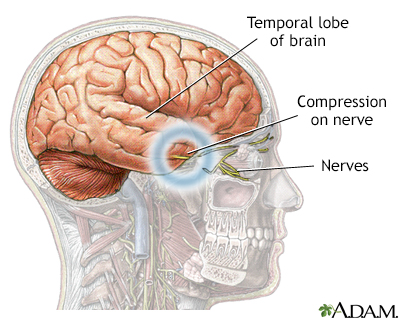Pregnancy SmartSiteTM
Herniation syndrome; Transtentorial herniation; Uncal herniation; Subfalcine herniation; Tonsillar herniation; Herniation - brain DefinitionBrain herniation is the shifting of the brain tissue from one space in the skull to another through various folds and openings. CausesBrain herniation occurs when something inside the skull produces pressure that moves brain tissues. This is most often the result of brain swelling or bleeding from a head injury, stroke, or brain tumor. Brain herniation can be a side effect of tumors in the brain, including: Herniation of the brain can also be caused by other factors that lead to increased pressure inside the skull, including:
Brain herniation can occur:
SymptomsSigns and symptoms may include:
Exams and TestsA brain and nervous system exam shows changes in alertness. Depending on the severity of the herniation and the part of the brain that is being pressed on, there will be problems with one or more brain-related reflexes and nerve functions. Tests may include:
TreatmentBrain herniation is a medical emergency. The goal of treatment is to save the person's life. To help reverse or prevent a brain herniation, the medical team will treat increased swelling and pressure in the brain. Treatment may involve:
Outlook (Prognosis)People who have a brain herniation usually have a serious brain injury. They may already have a low chance of recovery due to the injury that caused the herniation. When herniation occurs, it further lowers the chance of recovery. The outlook varies, depending on where in the brain the herniation occurs. Without treatment, death is likely. There can be damage to parts of the brain that control breathing and blood flow. This can rapidly lead to death or brain death. Possible ComplicationsComplications may include:
When to Contact a Medical ProfessionalCall 911 or the local emergency number or take the person to a hospital emergency room if they develop decreased alertness or other symptoms, especially if there has been a head injury or if the person has a brain tumor or blood vessel problem. PreventionPrompt treatment of increased intracranial pressure and related disorders may reduce the risk for brain herniation. ReferencesBeaumont A. Physiology of the cerebrospinal fluid and intracranial pressure. In: Winn HR, ed. Youmans and Winn Neurological Surgery. 8th ed. Philadelphia, PA: Elsevier; 2023:chap 69. Papa L, Goldberg SA. Head trauma. In: Walls RM, ed. Rosen's Emergency Medicine: Concepts and Clinical Practice. 10th ed. Philadelphia, PA: Elsevier; 2023:chap 33. Stippler M, Mahavadi A. Craniocerebral trauma. In: Jankovic J, Mazziotta JC, Pomeroy SL, Newman NJ, eds. Bradley and Daroff's Neurology in Clinical Practice. 8th ed. Philadelphia, PA: Elsevier; 2022:chap 62. | |
| |
Review Date: 7/26/2022 Reviewed By: Evelyn O. Berman, MD, Assistant Professor of Neurology and Pediatrics at University of Rochester, Rochester, NY. Review provided by VeriMed Healthcare Network. Also reviewed by David C. Dugdale, MD, Medical Director, Brenda Conaway, Editorial Director, and the A.D.A.M. Editorial team. The information provided herein should not be used during any medical emergency or for the diagnosis or treatment of any medical condition. A licensed medical professional should be consulted for diagnosis and treatment of any and all medical conditions. Links to other sites are provided for information only -- they do not constitute endorsements of those other sites. No warranty of any kind, either expressed or implied, is made as to the accuracy, reliability, timeliness, or correctness of any translations made by a third-party service of the information provided herein into any other language. © 1997- A.D.A.M., a business unit of Ebix, Inc. Any duplication or distribution of the information contained herein is strictly prohibited. | |

 Brain
Brain Brain herniation
Brain herniation
